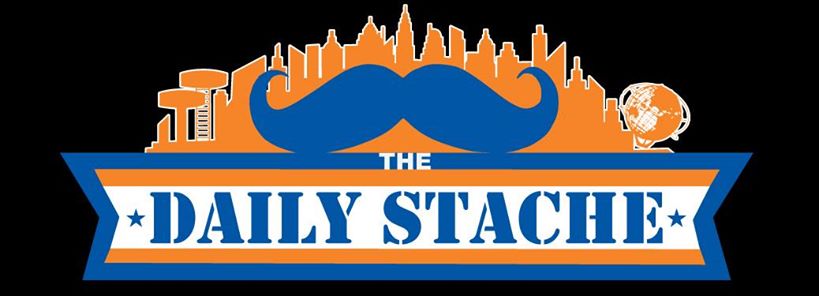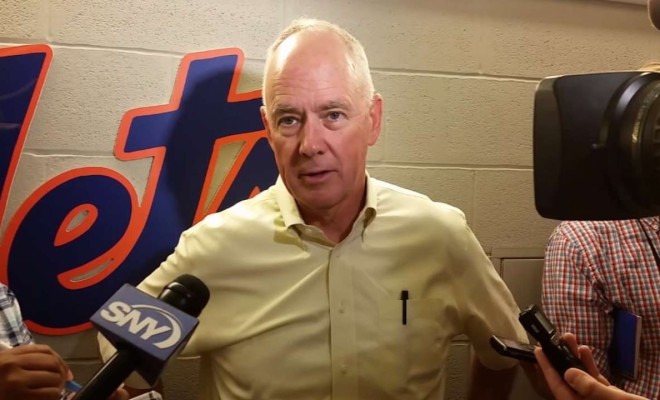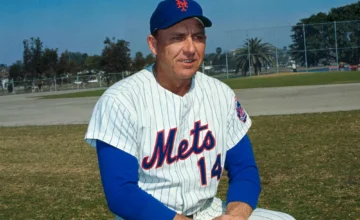I had resisted reading Steve Kettmann’s biography of Sandy Alderson, Baseball Maverick: How Sandy Alderson Revolutionized Baseball and Revived the Mets since I first saw it last Spring.
Several words sprang to mind. Chutzpah. Hubris. Jinx. It was Spring 2015, and the Mets were coming off of another disappointing season in 2014. Sure, Jacob de Grom won the Rookie of the Year and Juan Lagares netted himself a Gold Glove for some stellar work in centerfield. But this was the sixth straight losing season for the Mets, all since they’d moved into their beautiful new Citi Field. The ownership was still recovering from the financial havoc caused by their involvement with Bernie Madoff, Matt Harvey was trying to come back from Tommy John, and Zack Wheeler and Josh Edgin had just been diagnosed with elbow injuries requiring Tommy John surgery. It didn’t seem like the right time to publish a book on what an amazing job Sandy had done with the franchise. At that point, it seemed like the absolute wrong time to release a congratulatory tome about the oft embattled Mets General Manager.
Flash forward to today. The Mets are coming off a remarkable, Pennant winning 2015. They dealt with the losses of Wheeler and Edgin, watched three rookies make their mark with the team (Noah Syndergaard, Stephen Matz and Michael Conforto), overcame injuries to David Wright and Travis d’Arnaud, and saw Sandy pull off the greatest acquisition of a player by the Mets in recent memory when he stole Yoenis Cespedes from the Tigers. Now, with the benefit of hindsight seemed the perfect time to read this book, one which should have probably been written now and not 12 months ago.
Kettmann covers some well-worn turf with the first two thirds of the book. The first third covers how an army brat kid got into Dartmouth, did Marine ROTC during the height of campus anti-War sentiment in the 60’s, graduated top of his class out of officer’s school, demanded and got a command tour of duty in Vietnam when many others were trying to figure out how to avoid serving in Indochina, served in the honor guard when LBJ laid in state, and then went to Harvard law. The second third deals with how he came to become the GM of the Oakland A’s in the 80s through his relationship with the Haas family, owners of Levi-Strauss and purchasers of the A’s from Charlie Finley in order to keep the team in the Bay Area. But it is in the final third that we get insight into how Sandy approached the Mets and took a team from the bottom of the division and made them a winner.
Sandy was one of the first GM’s to embrace statistical analysis and SABREmetrics, and it was this approach which he brought to the Mets. As he explains at one point in the book, not every acquisition works out (see: Frank Francisco, Michael Cuddyer and Chris Young). But, when it doesn’t work out, you can go back to check how the statistics didn’t play out. It gives the team a baseline for reviewing where they went right and, more importantly, where they went wrong. You can see this with the trades of Carlos Beltran for Zack Wheeler and RA Dickey for Syndergaard, d’Arnaud, Wuilmer Becerra and John Buck. It also applies to the decision to make Wilmer Flores the starting shortstop last season. Finally, Kettmann’s reveals the decision to draft Michael Conforto out of college since he was Major League ready, after the Mets had used previous picks to restock the farm system with high school players like Domonic Smith.
One chapter that was of particular interest was the Mets failed pursuit of Robinson Cano. As some of you may recall, Cano was a dual representation by Jay Z’s Roc Nation and Brodie van Wagenen of CAA (a bit of trivia for us Baby Boomers, Brodie is the son-in-law of Apollo 11 astronaut Neil Armstrong). While Cano ultimately signed with the Mariners, Sandy developed a relationship with Brodie that would pay dividends when the Mets acquired Cespedes last summer. Cespedes had a unique contract that prohibited his current team from negotiating with him until May of the following season after he declared free agency. In addition, the Mets were unable to make a Qualifying Offer to Cespedes since he was traded during the season. First, Sandy and Brodie got Cespedes to waive the clause prohibiting the Mets from negotiating with him. Next, Sandy parlayed the good will and rapport he’d developed with Brodie to keep a line open while CAA explored other offers for Cespedes. When it became clear to all that the Cuban slugger wanted to stay in Flushing and after Cuddyer retired and refused a buyout, the Mets were able to sign Cespedes to a win/win contract for both team and player.
I would recommend Baseball Maverick to any baseball fan interested in learning the inner workings of one of the most successful General Managers in recent memory. It makes a good companion piece to Michael Lewis’s well known Moneyball, and may go down as a baseball Must Read like Roger Kahn’s The Boys of Summer, David Halberstam’s 1949, and Jim Bouton’s Ball Four.




